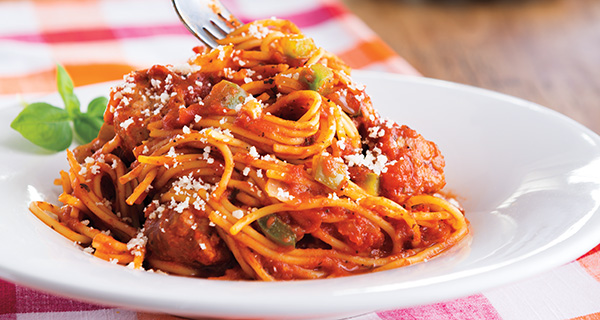Italian cuisine Spaghetti
Spaghetti is a long, thin, cylindrical pasta that is a staple in Italian cuisine. It's typically made from durum wheat semolina and water, and it is served with a variety of sauces, most commonly tomato-based sauces, but also meat sauces, garlic, and oil-based sauces. Spaghetti is one of the most popular pasta shapes worldwide due to its versatility and simplicity.

History of Spaghetti
The origins of spaghetti are closely tied to the history of pasta in general, which dates back several millennia. While it is commonly believed that the Chinese were among the first to create a form of noodles, the Italian version, specifically spaghetti, has its own rich history.
Spaghetti likely originated in Southern Italy. The word "spaghetti" is derived from the Italian word "spaghetto," which means "thin string" or "twine." By the 12th century, pasta made from durum wheat was widely consumed in Italy, particularly in Sicily, thanks to the influence of Arab traders. However, spaghetti became more popular throughout the country in the 19th century when it was dried and mass-produced.
Marco Polo is often credited with introducing pasta (including spaghetti) to Italy from China, but this theory is disputed, as pasta was already in existence in various forms in Italy long before Polo’s travels.
Today, spaghetti is enjoyed globally and is the centerpiece of classic dishes like Spaghetti Bolognese, Spaghetti Carbonara, and Spaghetti Aglio e Olio.
Types of Spaghetti
Though spaghetti is known for being long and cylindrical, there are a few variations based on thickness:
- Spaghettini – Thinner than regular spaghetti.
- Spaghettoni – Thicker strands of spaghetti.
- Capellini (Angel Hair Pasta) – Extremely thin spaghetti-like strands, often used in lighter sauces.
- Bucatini – Hollow spaghetti, a bit thicker than standard spaghetti, and has a hole running through the center.
Detailed Recipe for Spaghetti – Long, Thin, Cylindrical Pasta
Ingredients:
- 200g of spaghetti (regular, spaghettini, or spaghettoni, depending on preference)
- 1 tablespoon of olive oil
- 2 garlic cloves, minced
- 1 onion, finely chopped
- 400g canned tomatoes or fresh tomatoes, diced
- 1 tablespoon tomato paste
- 1 teaspoon dried oregano
- Salt and pepper to taste
- Fresh basil leaves (optional)
- Grated Parmesan cheese (optional)
- Water for boiling the spaghetti
Step-by-Step Process for Making Spaghetti:
Step 1: Boil the Spaghetti
- Prepare the Water – In a large pot, bring plenty of water to a boil (approximately 4 liters for 200g of spaghetti). Add a generous amount of salt (about 1 tablespoon per liter) to flavor the pasta while it cooks.
- Cook the Spaghetti – Add the spaghetti to the boiling water and stir occasionally to prevent sticking. The cooking time depends on the thickness of the spaghetti and your preference for texture:
- Spaghetti: 8–10 minutes
- Spaghettini: 6–8 minutes
- Spaghettoni: 10–12 minutes
- Check for Doneness – Taste a strand of spaghetti to see if it's "al dente" (firm to the bite), or cook longer for a softer texture.
- Drain the Pasta – Once the spaghetti is cooked to your liking, drain it in a colander. Reserve a small amount of the pasta cooking water for later use, as this helps thicken the sauce.
Step 2: Prepare the Sauce
Basic Tomato Sauce for Spaghetti:
- Heat Olive Oil – In a large pan, heat 1 tablespoon of olive oil over medium heat.
- Sauté Garlic and Onion – Add minced garlic and finely chopped onions to the pan. Cook for 3–4 minutes until the onions become translucent and the garlic is fragrant, but not burnt.
- Add Tomatoes – Stir in the diced tomatoes and tomato paste. If using canned tomatoes, break them down with a spoon as they cook. Simmer for 10–15 minutes.
- Season – Add dried oregano, salt, and pepper to taste. If the tomatoes are too acidic, add a pinch of sugar to balance the flavor. For extra flavor, add a few torn fresh basil leaves at the end of cooking.
- Thicken the Sauce – Let the sauce cook and reduce until it reaches your desired thickness. If the sauce becomes too thick, you can add a few tablespoons of the reserved pasta water to adjust the consistency.
Step 3: Combine Spaghetti and Sauce
- Add the Spaghetti to the Sauce – Once the sauce is ready, add the cooked and drained spaghetti to the pan with the sauce.
- Toss the Spaghetti – Toss the spaghetti in the sauce until each strand is well coated. Let it cook for 1–2 minutes in the sauce so it absorbs the flavor. If needed, add a little more of the reserved pasta water to make the sauce cling better to the spaghetti.
Step 4: Serve the Spaghetti
- Plate the Spaghetti – Use tongs or a pasta fork to twist and plate the spaghetti neatly.
- Garnish – Top the spaghetti with freshly grated Parmesan cheese and a drizzle of olive oil for extra richness. You can also garnish with fresh basil leaves for color and aroma.
- Optional Add-Ons – For additional texture and flavor, you can add a sprinkle of red pepper flakes, black olives, or capers.
Step 5: Enjoy the Spaghetti!
Serve the spaghetti immediately while hot, paired with crusty garlic bread or a fresh salad.
Optional Variations:
- Spaghetti Bolognese: Add ground beef or pork to the tomato sauce for a heartier, meaty dish.
- Spaghetti Aglio e Olio: Toss spaghetti in a simple sauce made from garlic, olive oil, and red pepper flakes.
- Spaghetti Carbonara: A creamy pasta dish made with eggs, pancetta or bacon, and Parmesan cheese.
This recipe provides a classic spaghetti dish that is simple yet full of flavor, perfect for any occasion!













0 Comments